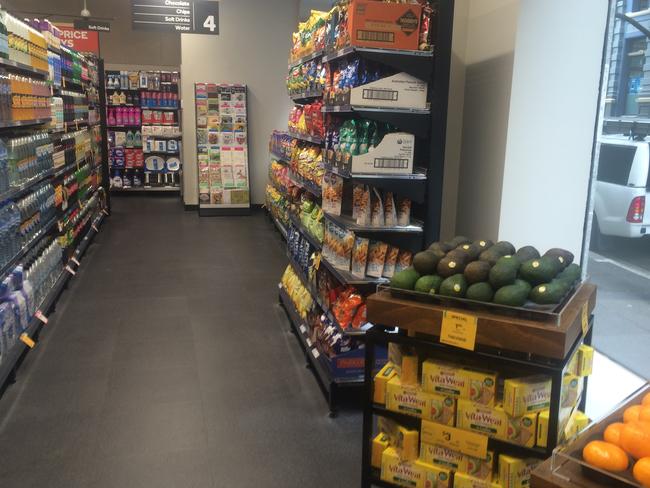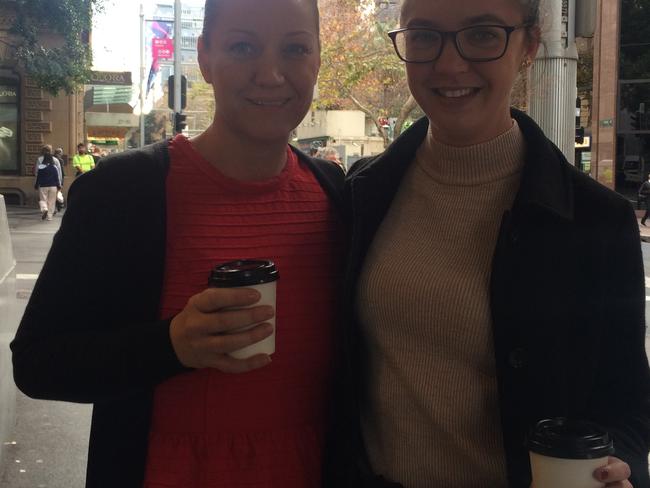Will smallest store save Woolies? What Metro concept says about Australia
WOOLIES is on a rescue mission. The under-pressure supermarket giant has a new focus to target time-poor, modern Australians.
A HOODIE-WEARING shopper clutching a coconut water rushes out, followed by a man in a suit holding a brown paper bag and two smartly dressed women with coffee.
What they have in common is that they are all moving very fast as they exit Woolworths’ smallest city store, where everything screams urban professional convenience.
The outlet, situated on York Street in Sydney’s CBD, has just 310 square metres of floor space, all optimised to draw in the crowds.
Busy customers wearing name badges and hi-vis jackets are greeted by shelves of sandwiches, salads, drinks and snacks, which can be combined in a $9 meal deal for a fast lunch. Nearby is a wall of fresh pastries for breakfast or breads to make toast tomorrow morning, and buckets of flowers to ease your guilt after you have to work late.
Then there are self-serve fresh soups with rolls, hot ready meals and plenty of office-pleasing bags of lollies and protein bars for your post-gym reward.
There are two tables of avocados in this precious space, showing that while Australia may be changing, a certain food obsession isn’t going anywhere. Vita-Weat crackers are stacked on a shelf below, because this store knows you a little too well.

The supermarket giant is hoping the concept helps rescue its fortunes after a difficult few years, and that the stylish new stores give it the edge over Coles Locals stores and Metcash, which supplies 7-11, IGA and other convenience stores.
It’s catnip for the suggestible. From the artfully lined up mini cans of tuna to the milk choc drizzle popcorn nestled below the superfood salads, it seems only practical to start buying up emergency snack supplies.
Yet it’s big enough to have rows and rows of typical supermarket supplies, meaning time-poor city dwellers could do a few “mini shops” or “top-up shops” and never need to take a big trip to a larger outlet.
The store already has two big fans, at least. “We love it!” Danielle Bergin, a 35-year-old who works at a nearby insurance firm, tells news.com.au as she walks out of the store with colleague Lisa Dunlop, 28. “We were just saying how much we love it. How sad is that?
“It’s awesome and heaps cheaper than Coles [a local branch up the road] because it has all the specials the supermarket has. And we got a free first coffee!”
Ms Dunlop adds: “The people are really nice.”

Software and business administrator Riley Johnson, 21, has popped in to buy paper towels and tissues for his office in the same building. “It’s cool, I was just in there two minutes,” he tells news.com.au. “It seems nice and easy and quick. I’d probably go reasonably often. The 7-11 across the road closed so it replaces that. It’s a lot cheaper and there are a lot more things.”
Woolies now has 16 Metro stores nationwide — seven in both NSW and Victoria and two in Queensland — and is planning to open more.
“This move to greater convenience store offerings is reflective of international trends and seen in other areas of retail given time-poor consumers,” a spokesman said. “Customers are shopping more frequently, buying smaller baskets of goods, and looking for a quick in-store experience. Our Woolworths Metro stores offer customers real choice and convenience.”
They’re squarely targeting the health-conscious modern Australian, with exclamatory signs everywhere you look: “Fresh to go”, “Fresh or free guarantee” and “hot out of the oven every couple of hours” over the bakery section.

Coles Local and Coles Express at Shell service stations have already brought the supermarket’s expertise around everyday convenience to the market, offering boxed chocolates, flowers and cards.
“It’s driven by denser populations, particularly in city and suburban areas in major capitals and transport hubs,” retail analyst Geoff Dart told news.com.au of the trend. “The strongest growing demographic is singles and couples without children (SWOCs), who have the highest disposable incomes. This group will represent approximately 55 per cent of households by 2031.
“Older people are generally not the target market, they’re not moving into the city areas, it’s really a younger demographic, upwardly mobile, single and couples looking for convenience.
“In areas where people aren’t driving, logistically it’s difficult for people to move out to find supermarkets.
“They’re largely living in apartments or townhouses, they’re time-poor and more inclined to eat out, so there’s an opportunity for takeaway meals. There’s a greater focus on fresh, ready-prepared food.”
Coles and Woolies bring “better buying power, ranges and supply chain power” to the convenience market, says Mr Dart. “The other thing they can bring is more competitive pricing. People will pay for more convenience but how much?”
He said we could expect to see many of these stores opening 24 hours, following in the footsteps of successful overseas city supermarkets such as Tesco Express and Sainsbury’s Local in the UK.
Even stores like Bunnings and Ikea are opening in smaller formats. “They’ve all realised big is not beautiful, it’s about having multi-formats for different demographics and those impulse purchases.”
This isn’t just about shopping, it’s about who Aussies are today.



